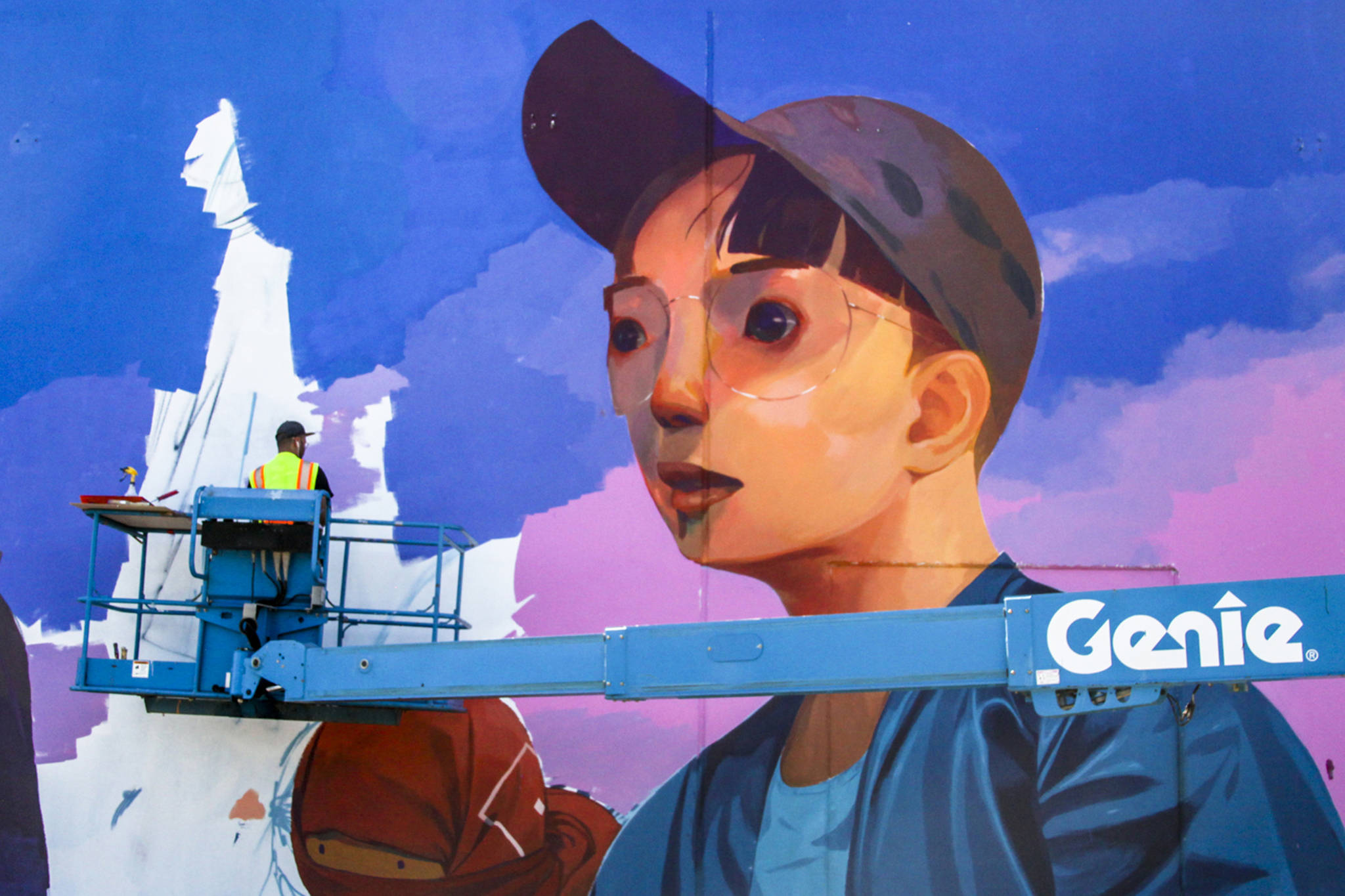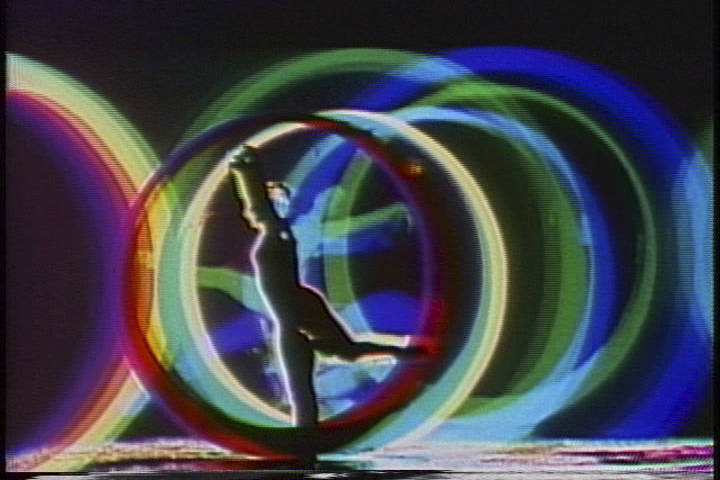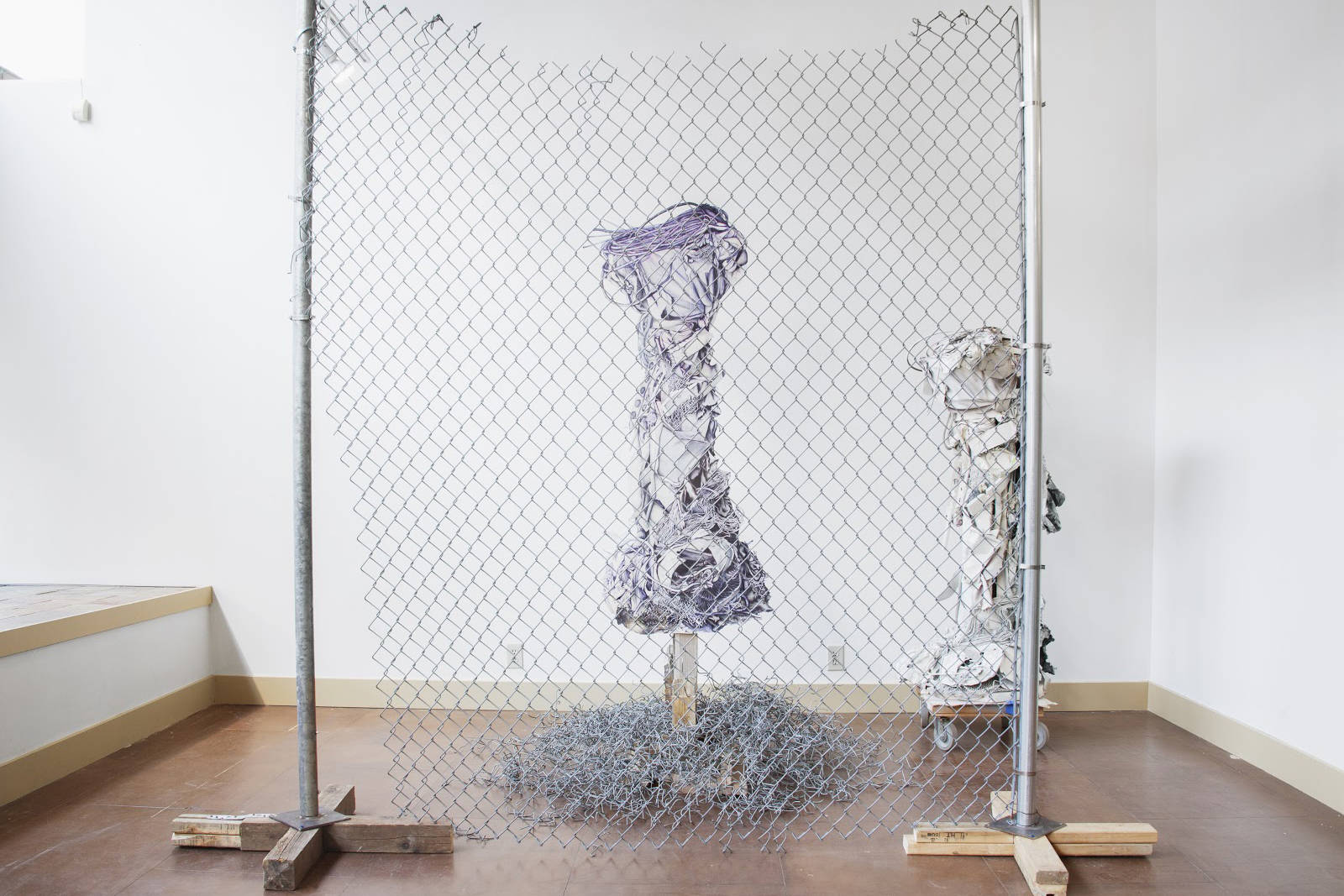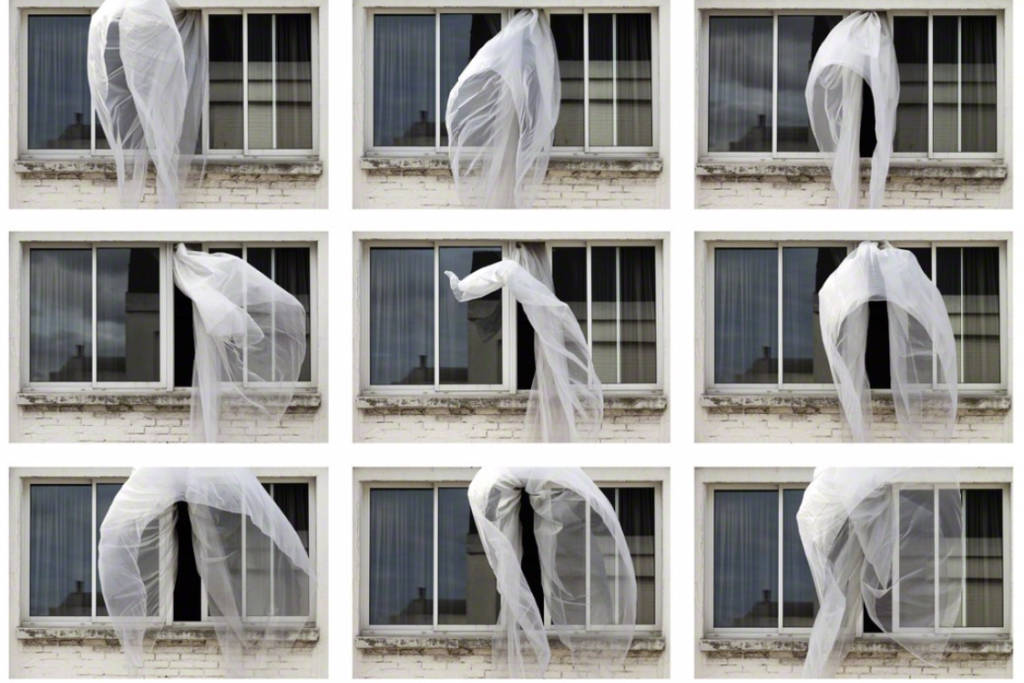We are standing on the train tracks along the SoDo busway. The heat beams red-hot, and the industrial area is still, save a faint electric whir. Crows squawk from above. “This one is Katy Ann Gilmore.” Tamar Benzikry points up and we squint at a mural of blunt, determinate black lines jutting from a vanishing block. “I call it exit through the portal.”
Benzikry, 4Culture’s Public Art Project Manager, coordinated SODO Tracks, a project to cover two miles of a transit corridor with murals by more than 50 artists. Most murals are complete, and the last phase of artists will paint in September. I rode a Route 150 bus to meet her along the tracks. “Do people ever get off to look at the murals?” I asked before getting off at Spokane Street. The bus driver glanced at me impatiently. “You don’t walk here. Homeland security will snatch you up if they see you.”
These murals, then, are designed to be viewed from public transit, as pop-ups in the landscape. “And they get a lot of eyeballs,” Benzikry remarks. According to Sound Transit’s data from 2016, the average weekday ridership for the SoDo busway is around 36,000 for Sound Transit and 13,000 for the Metro bus. 4Culture enlisted Gage Hamilton, a Portland-based artist and organizer of the mural festival Forest for the Trees, to select local, national, and international artists to respond to the theme of motion.
Some murals, such as Gilmore’s explosive perspective lines, are straightforward expressions of motion; others are broader interpretations. Benzikry and I stop at Baso Fibonacci’s mural, painted with the help of Jean Nagai. A prismatic wolf, painted in Fibonacci’s signature repetitive strokes, escapes a roaring fire. Fibonacci tells me later that in considering “motion,” he aimed to depict the crisis of displacement among artists. The wolf represents artists being chased out of the city, running south toward Renton, Kent, and Southcenter for cheaper rent. Fibonacci has been making art here for 10 years, and when you search “Seattle art” in Google Images, a mural he worked on for the Capitol Hill Light Rail Wall in 2010 is one of the first results. Our conversation becomes a lamentation of soaring housing costs, a common digression in most of my interviews with artists no matter our starting subject. He tells me he’s considering moving somewhere with a larger presence of working artists. I tell him that would be a huge loss for Seattle’s art community, and a somber pause fills the phone line.
 Baso Fibonacci and Jean Nagai in front of Fibonacci’s mural for The SODO Tracks. Photo by @wiseknave.
Baso Fibonacci and Jean Nagai in front of Fibonacci’s mural for The SODO Tracks. Photo by @wiseknave.
How do people look at art differently when they don’t anticipate it? When you go to a gallery, you internalize a set of social codes, prepare to parse the world through a certain conceptual language. On the bus you park your body and even your mental state, stare out the window absently, and let the whizzing landscape blur your thoughts. On why he’s drawn to murals, Hamilton explains that “your visual surroundings affect you a lot. Murals are art you stumble on, something beautiful and thought-provoking, that breaks you out of your thought process.” Murals, being outside, have a sense of public ownership, not to mention a rich history of spreading messages by and among political underclasses. This is popularly credited to the Mexican muralist movement, which flourished around the ’20s after the Mexican Revolution. Since most of the population couldn’t read, murals were an effective way to spread visual messages; movement members like Diego Rivera (Frida Kahlo’s husband), José Clemente Orozco, and David Alfaro Siqueiros would portray common laborers unifying and fighting in the Revolution.
Overlooked history remains a strong focus among the SODO Tracks. For his mural, Karl Addison painted a portrait of Mary Lou Slaughter and her son Michael Halady, descendants of Chief Sealth (after whom Seattle was named), watching over the area amid a lush, verdant rainforest. Addison grew up in Phoenix and spent much of his upbringing with his grandparents in the nearby Salt River Pima-Maricopa Indian Community. With this empathy and connection to Native Americans, he reached out to members of the Duwamish tribe, who helped him arrange travel to Port Orchard to meet the family. His SoDo portrait is significant to him because “the area was the main thoroughfare and native lands for the Duwamish people. When white American settlers came and razed the land to build the city here, it reduced the Duwamish River to what we see today. This land has only been like this for a little over 100 years. In a blink of an eye, the past is dried up and turned into warehouses and industrial endeavors.”
The murals are painted on the walls of active properties, which in SoDo remain predominantly manufacturing businesses. The scent of milk bread wafts by my nose as we approach the Franz factory. We pass the workspace for Skyline Flowers and glimpse workers separating and destemming florets. SoDo is the home of Interior Environments, Specialty Bottle, Canvas Event Space, and Western Safety, all of whom Benzikry spoke with personally about adorning their building with art. 4Culture is promising to protect the artists’ work for seven years. “We want this place to feel like it’s loved, like it’s well-tended.”
After ambling for 40 minutes along a half-mile stretch, pausing frequently to admire each mural, we get on the light rail to ride the rest of the mile and a half. We brace our stances in the middle lane so we can swing our heads both ways. The train accelerates. “There’s one,” Benzikry points. “There’s another one. That’s Cheyenne Randall … ” And before I can ask “Who?”, she says “ … and there’s Syd Bee and Casey Wheldon,” pointing to a downpour of tumbling pink cats that I see for a second, like a feverish hallucination. The fare enforcement officer makes his way to us and I fumble to scan my Orca card. “Let’s look there,” Benzikry says, and we slide over to a right-side window. I press my face to the glass and catch Cyrcle’s mural, a colossal text that reads “then out came the sun,” ominous like a divination.
To catch all the murals like this is frenzied and impossible. Benzikry tells me that longtime commuters can start to puzzle together the pictures over time, and for more infrequent riders they’ll be surprise blips—gems in the landscape. Maybe bus riders have seven years to piece this experience together—but who knows if the local artists who made them will still live here then?
The SODO Track by 4Culture, Fifth Avenue South between Royal Brougham Way and Spokane Street along the SoDo busway.
visualarts@seattleweekly.com








